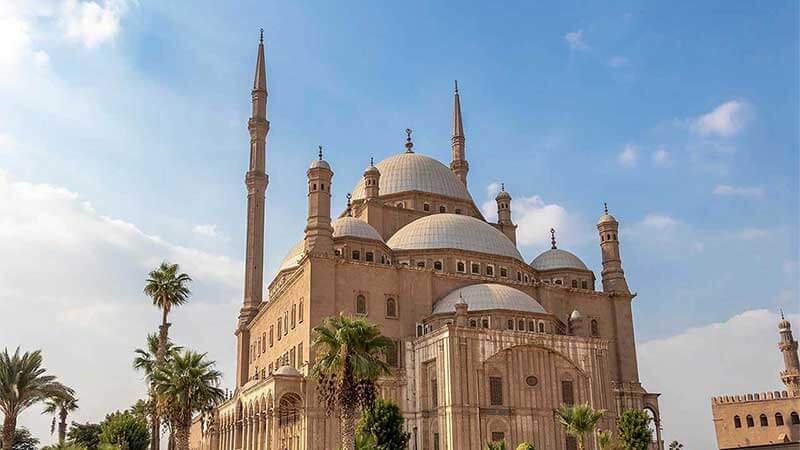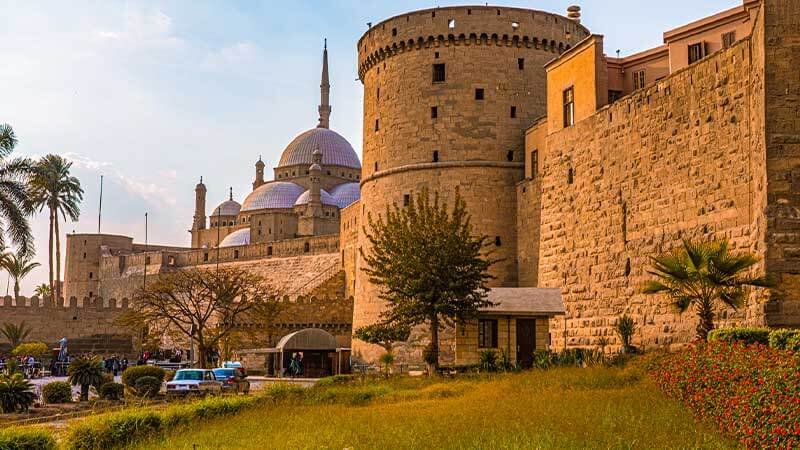Cairo, the sprawling capital of Egypt, cradles within its heart a splendid jewel – the Mosque of Muhammad Ali. This historic and iconic mosque is a testament to the grandeur of Islamic architecture and Egypt’s enduring Ottoman-era legacy. Famously known as the Alabaster Mosque, this awe-inspiring structure invites you to journey through time and faith as we delve into its captivating history, intricate design, and spiritual significance.
Don’t forget to read our related blogs:
Mosque of Muhammad Ali: A Historical Marvel

Perched high on the Muqattam Hills within the Citadel of Cairo, the Mosque of Muhammad Ali offers breathtaking panoramic views of the city below. Built in the early 19th century by the eminent Ottoman ruler Muhammad Ali Pasha, this mosque holds immense historical significance. Its construction spanned nearly three decades, from 1830 to 1857, showcasing its builders’ unwavering dedication and meticulous craftsmanship.
The Luminous Beauty of Alabaster
What truly sets the Mosque of Muhammad Ali apart is its extensive use of alabaster, a fine-grained, translucent mineral that radiates ethereal beauty. Alabaster clads the walls, minarets, and the grand dome, casting an enchanting glow when bathed in the sun’s golden rays.
A Harmonious Blend of Architectural Styles
This mosque is a harmonious blend of architectural styles, marrying the opulence of Ottoman design with subtle elements of classic Islamic aesthetics. Intricate arabesques, geometric patterns, and calligraphy adorn the walls, showcasing the artistic prowess of the era’s skilled artisans.
The Grand Dome: A Symbol of Unity
The mosque’s grand central dome, majestically rising to dominate Cairo’s skyline, symbolizes the unity of the Muslim community. Its mesmerizing geometric designs inspire contemplation and prayer, directing our gaze toward the heavens.
The Magnificent Minarets

The Mosque of Muhammad Ali boasts two elegant minarets, soaring approximately 82 meters (269 feet) high. These minarets serve as architectural marvels and traditional call-to-prayer towers, adding to the mosque’s spiritual significance.
The Enchanting Courtyard
Upon entering the mosque, visitors are greeted by a vast courtyard embellished with marble and adorned with serene fountains. This space provides a moment of solace, allowing one to escape the bustling city and embrace spirituality.
Exploring the Interior Splendor
Stepping inside, visitors are greeted with divine grandeur. Intricately designed prayer niches line the walls, while the spacious hall can accommodate thousands during religious gatherings. Majestic columns support the breathtaking central prayer hall, emphasizing the mosque’s vastness and architectural prowess.
Muhammad Ali’s Tomb: A Place of Reverence

The Mosque of Muhammad Ali serves as the final resting place of the visionary leader himself, Muhammad Ali Pasha, adding to its religious significance. Visitors can pay their respects to this iconic historical figure crucial in shaping Egypt’s modern identity.
The Calligraphic Masterpiece
Among its many impressive features, the mosque is adorned with stunning Arabic calligraphy featuring verses from the Quran, evoking a sense of divine beauty and spiritual enlightenment.
The Mihrab: An Architectural Masterwork
The mihrab, a semicircular niche indicating the direction of Mecca, is adorned with intricate mosaic work and calligraphy, signifying its sacred importance in the Islamic faith.
Captivating Light and Shadows
The interplay of light and shadows within the Mosque of Muhammad Ali is enchanting. Strategically placed windows and openings allow light to filter through, casting intricate patterns on the floors and walls, creating a serene and contemplative atmosphere for visitors.
A Symbol of Religious Tolerance
The Mosque of Muhammad Ali exemplifies the Islamic faith’s spirit and represents religious tolerance in Egypt. It welcomes visitors of all backgrounds, inviting them to witness its beauty and learn about the shared values that unite humanity.
The Mosque’s Role in Contemporary Times

Beyond its historical significance, the mosque remains a vibrant religious and cultural hub, hosting various events, lectures, and educational activities that promote interfaith harmony and cultural understanding.
The Mosque’s Influence on Art and Culture
Its stunning architecture has inspired artists, writers, and filmmakers for generations, contributing to its cultural legacy and global recognition.
The Mosque’s Enduring Cultural Impact
The Mosque of Muhammad Ali symbolizes religious devotion and is a testament to Egypt’s rich cultural heritage, as a reminder of the country’s glorious past.
Preserving a Historical Treasure
Through collaboration with international organizations, the Egyptian government diligently preserves the mosque, ensuring its architectural splendor remains intact for future generations to admire and appreciate.
Conclusion
In conclusion, the Mosque of Muhammad Ali is more than an architectural marvel; it is a beacon of spirituality, cultural richness, and historical significance. As a symbol of religious tolerance and unity, this magnificent mosque welcomes visitors from all walks of life to experience its splendor and spirituality. Exploring the Mosque of Muhammad Ali allows us to delve into the past while celebrating its enduring legacy, shaping the present, and inspiring the future.


